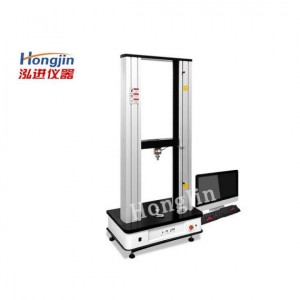
The electronic universal testing machine is mainly suitable for testing metal and non-metallic materials, such as rubber, plastic, wires and cables, fiber optic cables, safety belts, belt composite materials, plastic profiles, waterproof rolls, steel pipes, copper profiles, spring steel, bearing steel, stainless steel (such as high hardness steel), castings, steel plates, steel strips, and non-ferrous metal wires. It is used for stretching, compression, bending, cutting, peeling Tear two point stretch (requires an extensometer) and other tests. This machine adopts an electromechanical integrated design, mainly composed of force sensors, transmitters, microprocessors, load driving mechanisms, computers, and color inkjet printers. It has a wide and accurate loading speed and force measurement range, and has high accuracy and sensitivity in measuring and controlling loads and displacements. It can also perform automatic control experiments for constant loading and constant displacement. The floor standing model, styling, and painting fully consider the relevant principles of modern industrial design and ergonomics.
Factors affecting the functionality of electronic universal testing machines:
1、 Host section
When the installation of the main engine is not level, it will cause friction between the working piston and the working cylinder wall, resulting in errors. Generally manifested as a positive difference, and as the load increases, the resulting error gradually decreases.
2、 Dynamometer section
When the installation of the force gauge is not level, it will cause friction between the swing shaft bearings, which is generally converted into a negative difference.
The above two types of errors have a relatively large impact on small load measurements and a relatively small impact on large load measurements.
Solution
1. Firstly, check if the installation of the testing machine is horizontal. Use a frame level to level the main engine in two directions perpendicular to each other on the outer ring of the working oil cylinder (or column).
2.Adjust the level of the force gauge on the front of the swing rod, align and fix the edge of the swing rod with the inner engraved line, and use a level to adjust the left and right levels of the body against the side of the swing rod.
The main testable items of electronic universal testing machines:
The testing items of electronic tensile testing machines can be divided into ordinary testing items and special testing items. To determine the coefficient of material rigidity, the higher the ratio of the normal stress component in the same phase to the normal strain, the stronger and more ductile the material.
① Common testing items for electronic tensile testing machines: (common display values and calculated values)
1. Tensile stress, tensile strength, tensile strength, and elongation at break.
2. Constant tensile stress; Constant stress elongation; Constant stress value, tear strength, force value at any point, elongation at any point.
3. Extraction force, adhesion force, and peak value calculation.
4. Pressure test, shear peeling force test, bending test, pull-out force puncture force test.
② Special testing items for electronic tensile testing machines:
1. Effective elasticity and hysteresis loss: On an electronic universal testing machine, when the specimen is stretched at a certain speed to a certain elongation or to a specified load, the percentage of work recovered during contraction and consumed during extension is measured, which is the effective elasticity; The percentage of the energy lost during the elongation and contraction of the sample compared to the work consumed during elongation is called the hysteresis loss.
2. Spring K value: The ratio of the force component in the same phase as the deformation to the deformation.
3. Yield strength: The quotient obtained by dividing the load at which the permanent elongation reaches a specified value during tension by the original cross-sectional area of the parallel part.
4. Yield point: When the material is stretched, the deformation increases rapidly while the stress remains constant, and this point is called the yield point. The yield point is divided into upper and lower yield points, and generally the yield point above is used as the yield point. When the load exceeds the proportional limit and is no longer proportional to elongation, the load will suddenly decrease, and then fluctuate up and down over a period of time, causing a significant change in elongation. This phenomenon is called yielding.
5. Permanent deformation: After removing the load, the material still retains deformation.
6. Elastic deformation: After removing the load, the deformation of the material completely disappears.
7. Elastic limit: The maximum stress that a material can withstand without permanent deformation.
8. Proportional limit: Within a certain range, the load can maintain a proportional relationship with elongation, and its maximum stress is the proportional limit.
9. Coefficient of elasticity, also known as Young's modulus of elasticity.
Post time: Jan-18-2024
